ASUS Eee Pad Transformer Review
by Anand Lal Shimpi on April 21, 2011 4:00 AM ESTI've been on a bit of a tablet kick lately, so even if you have dinner with me—tablets are bound to come up (I only break out the SSD conversation for the truly patient). Last week I had the pleasure of having dinner with Tony Tamasi and Jim Black of NVIDIA, and of course—tablets came up.
I've been thinking about device synergy, something I brought up in our PlayBook review. The problem is as follows: if I'm on my desktop with half a dozen tabs open and perhaps a PDF as well, but I decide to switch over to a tablet—there's no quick way that I can transition my reading environment between the devices. What I have to do is sit down on the couch, whip out my tablet, and manually navigate to each website and redownload/open the PDF. What I'd like to do is something along the lines of HP's Touch to Share, but just on a larger scale.
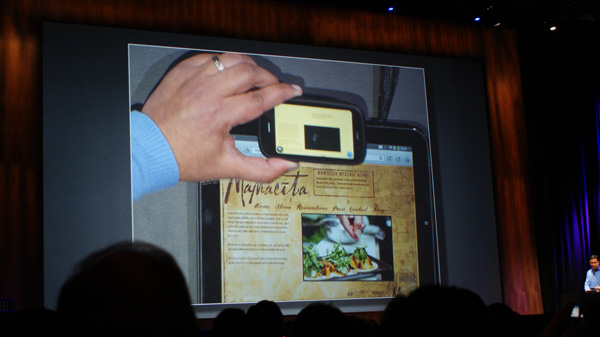
HP demonstrating Touch to Share
I posed this question to Tony when he asked me about future tablet technologies. From Tony (and NVIDIA's perspective), the problem is a non-issue because eventually all computing is done on your smartphone and you simply dock it from one set of input/output devices to the next. At your desk you'll dock your smartphone to a large display, keyboard and mouse. On the go you'll either have your smartphone or dock it into a notebook like chassis. Presumably you'll have a mid-sized display you could tether it to for tablet use as well.
NVIDIA isn't the only company that believes in the future of dockable computing. Earlier this year Motorola released the Atrix, arguably the best overall Android phone on the market today, with an optional laptop dock. While Motorola's docked experience wasn't all that great, treat it as a proof of concept—there's potential here.
You might argue that Motorola's shortcomings with its laptop dock are a result of its unfamiliarity with making PCs; after all Motorola has never shipped a laptop, just smartphones. You might also argue that a PC maker would have an easier time delivering a more polished, functional solution. You might assume that a company like ASUS might be a good candidate for such a thing. You'd be right.
The Eee Pad
ASUS was at the forefront of the netbook revolution thanks to its close partnerships with Intel and Microsoft. ASUS has been all but absent from the smartphone and tablet revolution again, because of its two key partnerships: Intel and Microsoft. Both Intel and Microsoft lay dormant while the smartphone and tablet revolution pick up speed; granted this may all change around Windows 8, but for now it's the truth. If you're a partner of both Intel and Microsoft, you too lay dormant while competitors like Apple, Samsung, Motorola and LG take your cake. After more than enough thumb fiddling, it was ASUS' turn for a slice. The result is this:
Technically it's called the Eee Pad Transformer TF101 thanks to its ability to transform into a netbook/notebook with an optional keyboard dock and ASUS' inability to shy away from long model names. From here on out we'll just call it the Eee Pad.
At a very high level, the Eee Pad is yet another Honeycomb tablet. It's got an NVIDIA Tegra 2 SoC, 1GB of LPDDR2 memory, a WiFi radio, and 16GB of NAND on-board. Delve a little deeper and the story quickly becomes more interesting.
We'll start at the price: $399 for 16GB WiFi. That's $100 cheaper than the equivalent iPad, and $200 cheaper than the lowest priced Xoom. I've often called tablets luxury devices, but ASUS is putting the price pressure necessary on these things for the market to really thrive. While $399 isn't into the "why not?" category just yet, I like where ASUS is headed with this. In other words, I don't believe $399 is the floor here either. Up to now tablets (and smartphones) have been a cash cow for those involved. I don't mind there being premium offerings; I just also want to see something more affordable.
The low price point alone is enough to make the Eee Pad worth considering if you want an Android tablet, but surprisingly enough ASUS didn't sacrifice much in the way of quality to hit it.
The chassis isn't all metal, nor is it soft touch plastic, but that's not to say the feel is bad at all. On the front you've got mostly glass surrounded by a thin strip of metal that wraps around the Eee Pad. Around back there's a textured plastic covering that seems oddly reminiscent of a notebook (the foreshadowing here is quite thick).
The feel is what's most surprising about the Eee Pad. Despite not spending a ton on materials, ASUS managed to build a very comfortable to hold and use tablet. There's a bit of creakyness in the back plastic if you squeeze the Eee Pad, but it's not enough to make the tablet feel cheap. A benefit of not being made of aluminum is I'm not as afraid to set the Eee Pad down on a table as I am the iPad. It feels more rugged, more casual.
| Tablet Specification Comparison | ||||||
| Apple iPad 2 | ASUS Eee Pad | BlackBerry PlayBook | Motorola Xoom | |||
| Dimensions | 241.2mm x 185.7mm x 8.8mm | 271mm x 175mm x 12.95mm | 194mm x 130mm x 10mm | 249.1mm x 167.8mm x 12.9mm | ||
| Display | 9.7-inch 1024 x 768 | 10.1-inch 1280 x 800 | 7-inch 1024 x 600 | 10.1-inch 1280 x 800 | ||
| Weight | 601g (WiFi only) | 675g | 425g | 730g | ||
| Processor | 1GHz Apple A5 (2 x Cortex A9) | 1GHz NVIDIA Tegra 2 (2 x Cortex A9) | 1GHz TI OMAP 4430 (2 x Cortex A9) | 1GHz NVIDIA Tegra 2 (2 x Cortex A9) | ||
| Memory | 512MB | 1GB | 1GB | 1GB | ||
| Storage | 16GB up to 64GB | 16GB + microSD card | 16GB up to 64GB | 32GB + microSD card | ||
| Pricing | $499 up to $829 | $399 | $499 up to $699 | $799 | ||
The Eee Pad has the thickness of an original iPad without the density, so it doesn't feel as fatiguing to hold—partially due to its larger size. It's definitely the largest ARM based tablet I've used, making it suboptimal for porting around town, but it's very nice to use at home. The Eee Pad is like the comfort food of tablets; it's not the most exquisite but it just feels good. My only complaint about the design is thickness. The iPad 2 and new Galaxy Tab have spoiled us here. I suspect we'll get a nicely redesigned version with Kal-El by the end of the year if NVIDIA works hard enough.
When cutting costs the display is usually the first to go, but thankfully our complaints have been heard. Not only has ASUS improved display quality on the notebook side, but the Eee Pad ships with an IPS panel guaranteeing good viewing angles and image quality. The display is a Xoom-like 1280 x 800 and measures 10.1-inches on the diagonal.
ASUS includes two small speakers, one on either side of the display. A volume rocker and power/lock button are both on the left edge of the Eee Pad. On the right side there's a headphone port, mini HDMI out and microSD slot.
The Eee Pad has two cameras: a 1.2MP front facing camera and a 5MP rear camera. There's no flash present.
Along the bottom edge of the Eee Pad is a 40-pin ASUS dock connector, which enables the Transformer part of the Eee Pad experience. ASUS ships the Eee Pad with a 40-pin ASUS dock to USB cable as well as a USB to AC adapter for wall charging.
Charging over USB is ill advised at this point since it'll take somewhere over 16 hours to fully charge the Eee Pad over a standard USB port. ASUS claims this will be fixed with a future software update. I didn't have the time to measure exactly how long a full charge over USB would take; I just measured long enough to know it would be a problem.


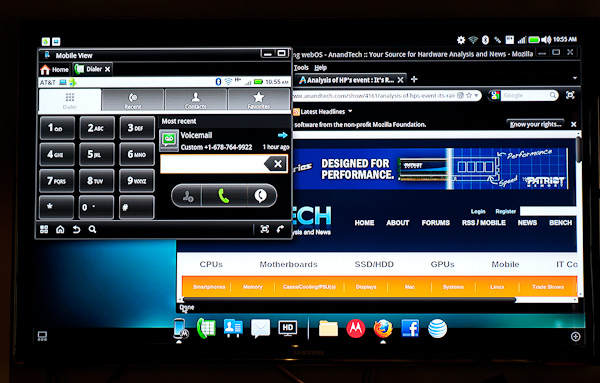
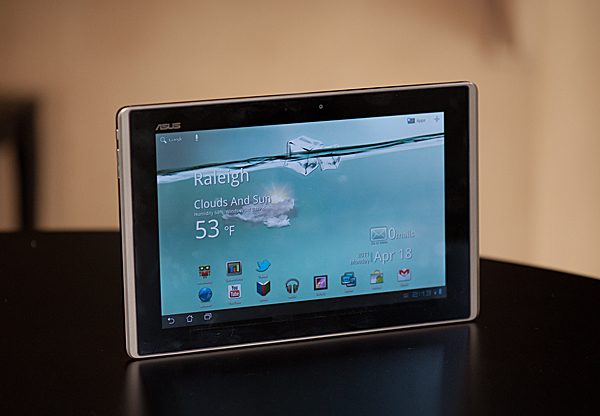
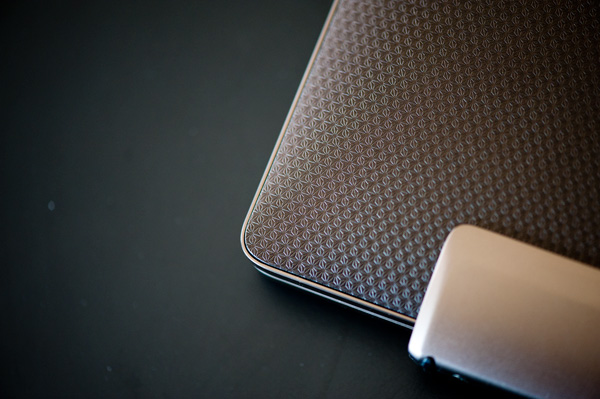
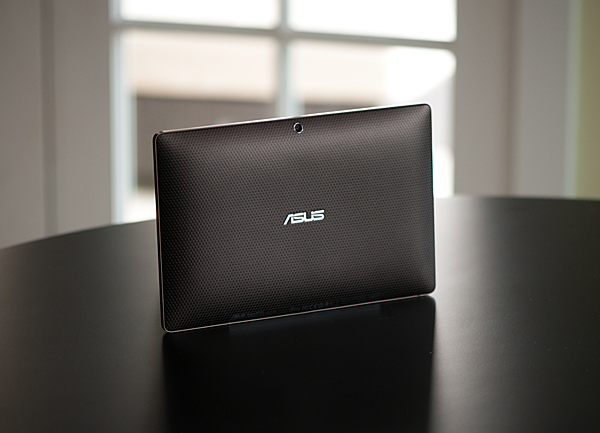
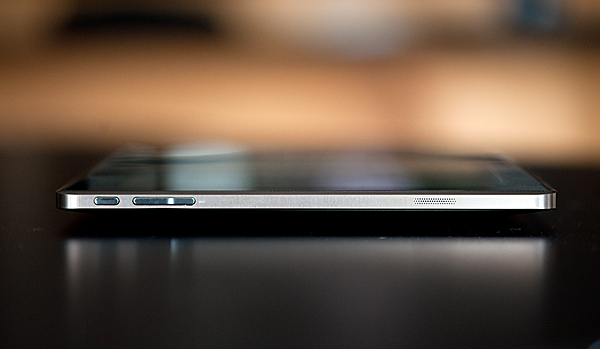

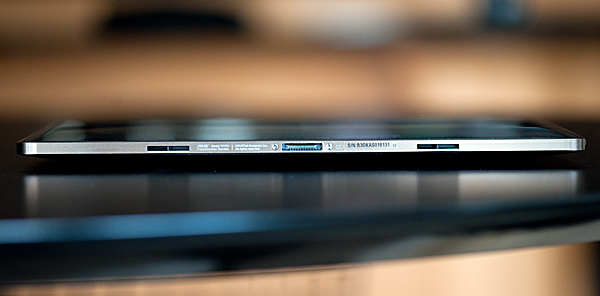









127 Comments
View All Comments
stmok - Thursday, April 21, 2011 - link
"I always remember what AMD's Eric Demers once told me: the best way to lose a fight is to not show up."That's the problem with the majority of today's technology companies. Instead of producing quality solutions and services that make them stand out over their competition, they persist with the thinking of getting into the market first...At the cost of everything else.
Result?
* It costs you money...After sales support. (Whether it be fixes, updates, extra warranty costs, etc.)
* It costs you reputation with consumers. (Firmware issues in a review product?)
* You're seen as just another clone tech company. No different to any other. *Yawn*
Old school thinking that has been lost over time...
=> You turn up to a fight prepared to win the encounter. No excuses.
What does that really mean in today's competitive global market.
=> You don't BS the reviewers and consumers with excuses. (This is just telling me one is not taking complete responsibility of what they're making/providing in service or product.)
=> You focus on constant improvement. (This means actually finding root causes to the problems you have, so they don't end up seen by consumers/reviewers. Everyone gets involved in this process. Employees should be encouraged to do their best work...And not based on some quota.)
=> You aim to provide quality products and services. (Customer satisfaction pays back in the long term as previous buyers will come back and bring their friends with them.)
All this stuff is NOT new. It all came from the WWII generation.
MilwaukeeMike - Thursday, April 21, 2011 - link
The WWII generation doesn't hold for tech firms. A car needs to be of extremely high quality, 6 sigma quality. A tech product doesn't, mainly because there are zero saftey issues and your product can be fixed via firmware updates.Here are two stories. Duke Nukem sequel called Duke Nukem Forever (DNF). They strove for perfection, changed their frameworks and technology to stay current, doubled their budget about 3 times and eventually threw in the towel. Amazon when it started had the mantra Get.Big.Fast. and look where they are today.
Don't forget the 80/20 rule. If they told me i could only take 1 picture a week with my tablet I'd be ok with that. I probably wouldn't take any. Fixing the last few bugs in a system can often be so expensive and provide so little benefit it's not worth the cost. I'm confident they'll fix the docking problems, but I don't even care about the camera. I'd rather it be removed and the price lowered.
Tros - Thursday, April 21, 2011 - link
No.WWII Generation holds for all things people want to be productive. It might not hold if you want a tablet that eats your reviews when it freezes (see: toy). But it definitely holds.
Your stories should be irrelevant by your own argument ("doesn't hold for tech firms").
But I feel like DNF is the exact example as to why stmok is right. Duke Nukem 3D is awesome, and gathered a cult following with its quality. And this is primarily why DNF is heavily anticipated. I doubt you'll find any decent gamer who won't buy into this game once released, just to see what 3D Realms had cooking all this time.
I don't think any amount of sense works against ingrained MBA jargon. Really what you're just saying is that buying a tablet with camera hardware and no ability to take pictures is okay, because it's so cheap anyway. Then, a second conflicting philosophy that the camera should be removed and the price lowered.
Why not just take that philosophy all the way and say that if the tablet doesn't work, then they shouldn't sell it?
erple2 - Thursday, April 21, 2011 - link
I can tell you that for the business of software development, you're not right. Schedule matters FAR more than "Getting it right the first time". You ALWAYS have a chance to fix mistakes and bugs. But if your window of opportunity passes you by, there's nothing to release.If a developer makes some software that nobody uses because it was never released, does it matter that they ever developed that software? No.
The tech hardware firms have very similar outlooks (as they should). The issues Anand pointed out in the review appeared to be primarily software related. The implication is that ASUS/Google can release software updates to fix those problems. The vast majority of the functionality is there, and works well. You need to realize that ALL PRODUCTS that do something more complicated than toast a piece of bread have defects in them. Whether that's software or hardware. The value of the product (and the "maker" of the product) is how responsive they are about fixing those products.
The nature of software development in the modern world (non-waterfall, glacial-paced release schedules) dictates that you have to be able to do small, quick releases, with patches to those in a timely fashion. The key there is that you have to get your product to market (or at least to the customer) quickly. I've worked in the industry for quite some time on a LOT of programs/projects. I can say that out of 24 customers, 23 of them would rather you deliver 80% of the product on time (with a patch for the remaining 20% later) than release 100% of the product 20% later than promised. What does that mean? "The best way to lose a fight is to not show up". None of the fights you have in the tech world are life and death situations, except that you assure your own death if you don't show up. You don't get a second chance in that regard. You also realize that things are always negotiable.
Cuhulin - Monday, April 25, 2011 - link
You're missing the point with the "schedule matters". If you arrive with a buggy product, you haven't hit the opportunity. People write about the bugs, you get rejected, and you never get another chance.Perfection doesn't matter. Having the important things work, even if there is an issue on the edges, is what matters.
Cuhulin - Monday, April 25, 2011 - link
Please let me know what tech firm you run; I'll not buy your products!The issue is not being perfect, it's getting the important things right. Amazon recognized the economics of its business, yes, but it also recognized that blowing deliveries would cause people not to use it again, opening the door for new competitors and endangering its goal.
Think of how many tech products have died because the early reviews said they were buggy or slow -- all fixable with changes, but they never really got the chance. Wordstar 2000 killed the entire product line when it was the dominant word processor -- it needed was optimizing code for speed, and it got it, but too late. Many a game has died because the initial reviews said it was buggy, and the name was ruined even though the bugs got fixed.
It isn't a question of being perfect. Cars have bugs too. It's a question of knowing which things matter and getting those right, quickly.
Rick83 - Thursday, April 21, 2011 - link
"To the left of the space bar are search, home and a Fn modifier key in that order.. The search key activates the Honeycomb search widget, home takes you home and we all know what Fn does."Shouldn't long-pressing home bring up the task-switcher?
It does on my Archos 5 IT (with USB/BT Keyboard)
oliwek - Saturday, May 7, 2011 - link
it's not a problem, if you need it just install a task-switcher from the store, it works even on an android phone, linked to for example a double-click on the HOME buttonElrondolio - Thursday, April 21, 2011 - link
Excellent review, Anand. I'm a little surprised that you didn't stress the utility of having a "stand" of sorts for the general browsing experience. I remember one of your earlier pad or phone reviews that harped on the difficulties of holding a device while using it comfortably in ones lap, specifically while trying to type if I remember correctly. Having this dock would alleviate much of those earlier issues you brought up.I'm definitely in line for this Eee Pad, even with its current, however limited, flaws. Having an all day (even those long, long day) touch tablet with decent sized and quality screen, keyboard and thousands of apps in the near future is exactly what I've been waiting for. 3 pounds isn't too bad either considering you can ditch half that when you desire to. Most of all, its great to hear the dock will be compatible with their future Eee Pads, as I'll be upgrading and simply handing down the earlier models to thankful kids.
Great review, thanks Anand. On a side note: not often do I notice the quality of product shots (the photography specifically), but this article caught my eye in that regard. I love your choice of lens on these... would be interesting on hearing what very fast glass was used (F1.2 or faster?).
strikeback03 - Thursday, April 21, 2011 - link
Doubt anything nearly as fast as f/1.2 was used here, most lenses of that class don't focus all that close. I wouldn't be surprised if it is something in the neighborhood of a 100mm f/2.8 macro, and might not even be wide open.